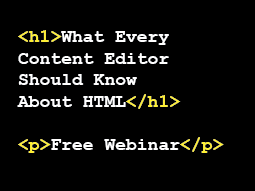Basic HTML Literacy for Authors and Editors

HTML is the lingua franca of the web. Virtually all content on the web uses HTML.
Web developers must, of course, be expert users of HTML. People who write and edit content for web, on the other hand, typically seek to avoid having to deal with HTML by using WYSIWYG (what you see is what you get) editors.
While WYSIWYG editors can be convenient, and are often a reasonable way to edit content, they are also the source of much grief. They hide from the users the realities of the HTML markup that the editor is generating, and they have no way to represent elements that do not have a direct visual representation.
By learning the rudiments of HTML, everyone who writes or edits content for the web can improve the quality of their work and reduce the number of situations in which they must ask for help from an expert. Yet most people continue to avoid HTML as if it were hopelessly complex.
The reality is that the essence of HTML is simple, and can be learned by anyone in less than an hour. It is empowering to be able to read and modify basic HTML, and in today’s world this should be part of basic literacy. You might choose to continue using WYSIWYG editors, but the ability to switch into source view and fix issues is invaluable.
Why do people avoid HTML? Perhaps they think programming is beyond them—but HTML is not programming, it is markup. Or maybe they have seen complex web page code and found it impenetrable, or they have been intimidated by the web development priesthood.
To help everyone move toward basic HTML literacy, we have put together a free one-hour webinar, What Every Content Editor Should Know About HTML, that we will present Tuesday, July 28, at 11 am PDT. You can sign up and join us live, or check that page after Wednesday for the recorded webinar.
Topics: Web Design, HTML5 and CSS3

